Introduction
This page has been updated to include the 25 old trebles at Bournville. These were replaced in 2015 but have been preserved in the school.
This is one of a pair of papers about the Gillett & Johnston tuning forks. This paper focusses on the practical impact of errors in the forks on carillons and change-ringing peals. The other paper gives details of the history of the forks, the history of their preservation at Taylors Bellfoundry, and recent measurements demonstrating an unexpected pattern to the errors.
The forks used to measure and tune the partials in G&J bells have been known for a long time to be incorrect. But this is the first time that all the 2,044 forks have been measured, probably since they were made in the early / mid 20th century. The deviation in their frequencies cycles across the octaves – all the A forks are flattest, and all the E♭ forks sharpest. The variation across each octave is up to 25 cents or a quarter of a semitone. The lowest and highest and highest frequency forks are flat by around 75 cents or three-quarters of a semitone.
These errors, in particular the octave cycle, are immediately visible in the tuning figures of carillons and peals, as will be seen below.
This idea was originally suggested to me by Scott Allan Orr in a discussion at the 2021 meeting at Loughborough of the Carillon Society of Britain and Ireland. Recordings taken of the Saltley carillon at the CSBI meeting in 2022 provided enough data for the first meaningful analysis.
The tuning records created by Gillett and Johnston for each bell survive and transcriptions of them by Alan Buswell were used in this investigation. The records have the weight and diameter of each bell as completed, together with frequencies for hum, prime, tierce, quint and nominal. In the 1930s records they also sometimes include the high fifth between nominal and superquint, and partial I7.
Errors in the forks
The detail behind the plots shown here is explained in the other paper.
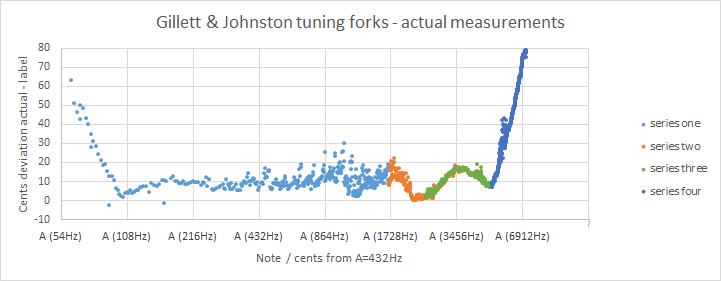
This plot shows the variation in the forks between the frequency stamped on the fork, and the measured frequency. The vertical axis is the difference in cents between the two. The lower the point on the chart, the nearer to the correct frequency. Higher points on the chart indicate that the fork is flatter.
The horizontal axis is the frequency stamped on the fork relative to A=432Hz, given in cents. The choice of frequency standard is arbitrary, the chart would have the same form if plotted with A=440. The vertical divisions are octaves. The data has been presented in this way to emphasise the cyclic variation by octaves.
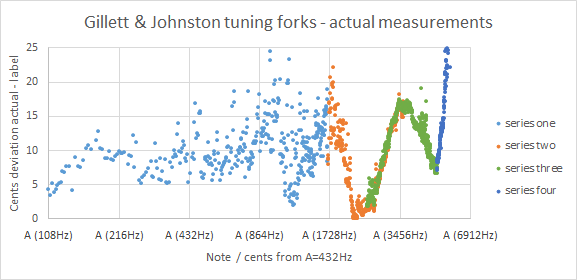
Here is the same data, but plotted with reduced scales on the vertical and horizontal axes, matching exactly the scales used below. This plot shows more clearly the octave variation.
Carillons and peals in this study
G&J carillons included are:
- Toronto, Metropolitan United Church, cast 1921/2, recorded 2019
- Princeton, New Jersey, cast 1926 / 1927, recorded 27 October 2019
- Toronto University, Soldier’s Tower, cast 1927, recorded 2019
- Saltley, cast 1932, recorded 29 October 2022
- Bournville, cast 1934, recorded 22 February 2020 and 26/3/2023.
Change-ringing peals included are:
- Coventry, cast 1927, recorded by Mike Chester 26 November 2001
- Croydon Minster, cast 1936, recorded 4 January 2022.
All the recordings except Coventry and the Toronto carillons were taken with a calibrated laptop / pre-amplifier accurate to ±0.05Hz at 500Hz and 600Hz. The Toronto recordings were provided by Scott Alan Orr.
Small carillon bells are affected by atmospheric pollution and corrosion, which generally lowers their frequencies. All the top bells at Princeton were replaced by Paccard in the 1960s, but the bottom 28 bells (excluding the bass semitone added by Paccard) remain as cast by G&J.
All 23 bells at Saltley and the Toronto carillons remain as cast by G&J.
All the small bells at Bournville were replaced by Taylors in 2015. Four of the bass bells are Taylor bells from a previous chime at the school. Fortunately, the G&J records include the partial frequencies of these bells measured using the G&J forks, so all 23 bass bells including the four Taylor bells were included in this investigation.
The peals at Coventry and Croydon remain as cast.
Comparison of measured frequencies
In all the plots below, the vertical axis is the difference in cents between the frequency measured for a partial, and the frequency given for that partial in the tuning book. The measured frequencies are almost always flatter than the figures in the book.
The horizontal axis is the frequency of each partial, given in cents relative to A=432Hz. The bells at Bournville, Saltley, Coventry and Croydon were tuned to A=432, those at Princeton to A=435, but this difference is not material to the investigation. The horizontal scale is marked with the octaves.
Six measurements were excluded from the analysis, where it appears the entry in the G&J books is incorrect. The total number of partials included across all three carillons is 884, which is an average of 6 partials per bell.
In the plots below, there are no high frequencies for the Toronto carillons, Princeton and Coventry because the G&J records don’t include the high fifth or partial I7 for these bells. The installations are presented in date order. The carillon installed at Toronto Metropolitan United Church is very probably Cyril Johnston’s first carillon sent to a customer, following one built in the works in 1920 which was later dismantled (ref 1). All the Toronto MUC bells except one were cast in 1921.
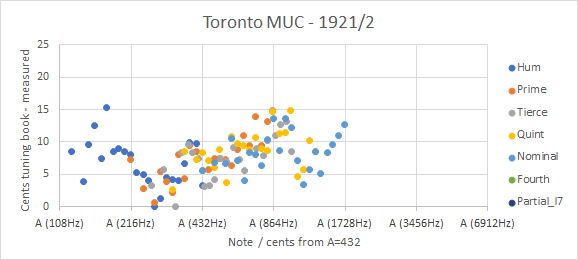
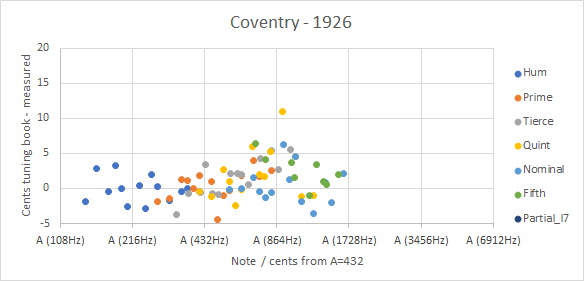
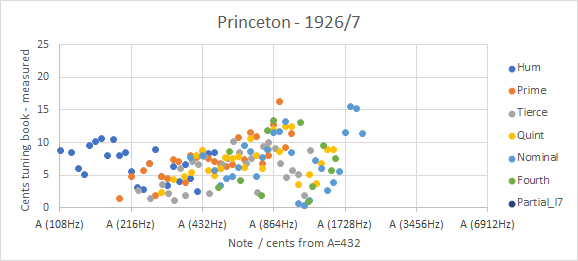
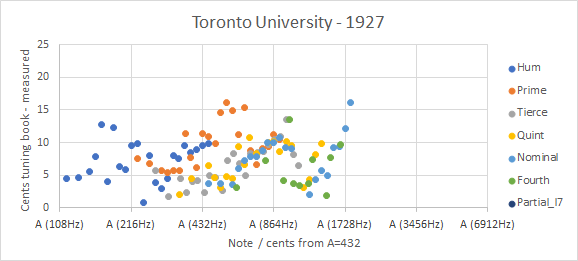
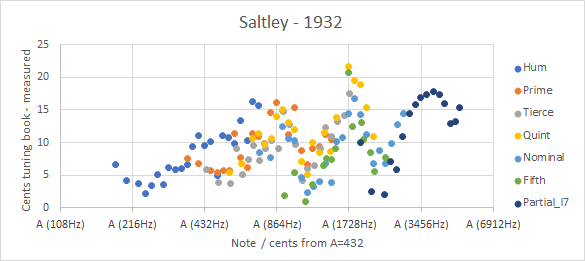
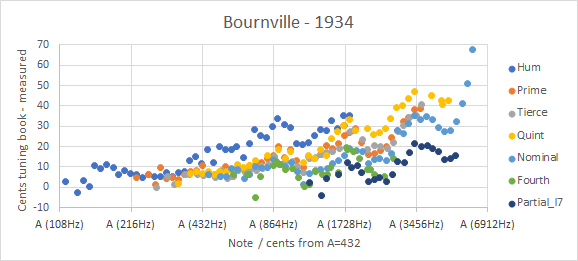
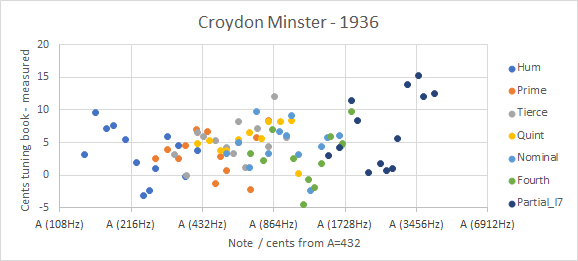
The cyclical variation in the charts from the middle of the plots upwards is clear in every case, except Coventry where a cycle is plausible but there are not enough high-frequency partials to confirm it. The variation in the figures appears to be periodic in octaves, with the As having the biggest discrepancy in each octave, and the Ds or Ebs the least. The variation across the octave is considerable, and amounts to 20 cents or a fifth of a semitone.
There is also a hint of cyclic variation in the lowest octave, but the frequencies in this octave are low and very susceptible to measurement errors.
The vertical scale of the Bournville plot is different from that of the others. This carillon is in the open air, in what was an industrial area. The trebles were replaced with new bells in 2015 because they no longer sounded in tune. The plot includes the old trebles, which have been preserved. The cycle of errors across the octaves is visible, as is the considerable flatness of the very highest frequencies, just as in the fork measurements. However, the different partials show different degrees of flatness and this is being investigated further.
Acknowlegements
My thanks are due to the various carilloneurs for permission to record their carillons: Lisa Lonie at Princeton, Mike Boyd at Saltley, and Trevor Workman and Arthur Casey at Bournville; to Mike Chester for the Coventry recordings; to Scott Alan Orr for the Toronto recordings; to Shirley McGill for permission to record the bells at Croydon Minster; and to Alan Buswell for transcribing a large number of G&J tuning records.
References
- Johnston J, England’s Child, Cadmus Editions 2008, p 273.